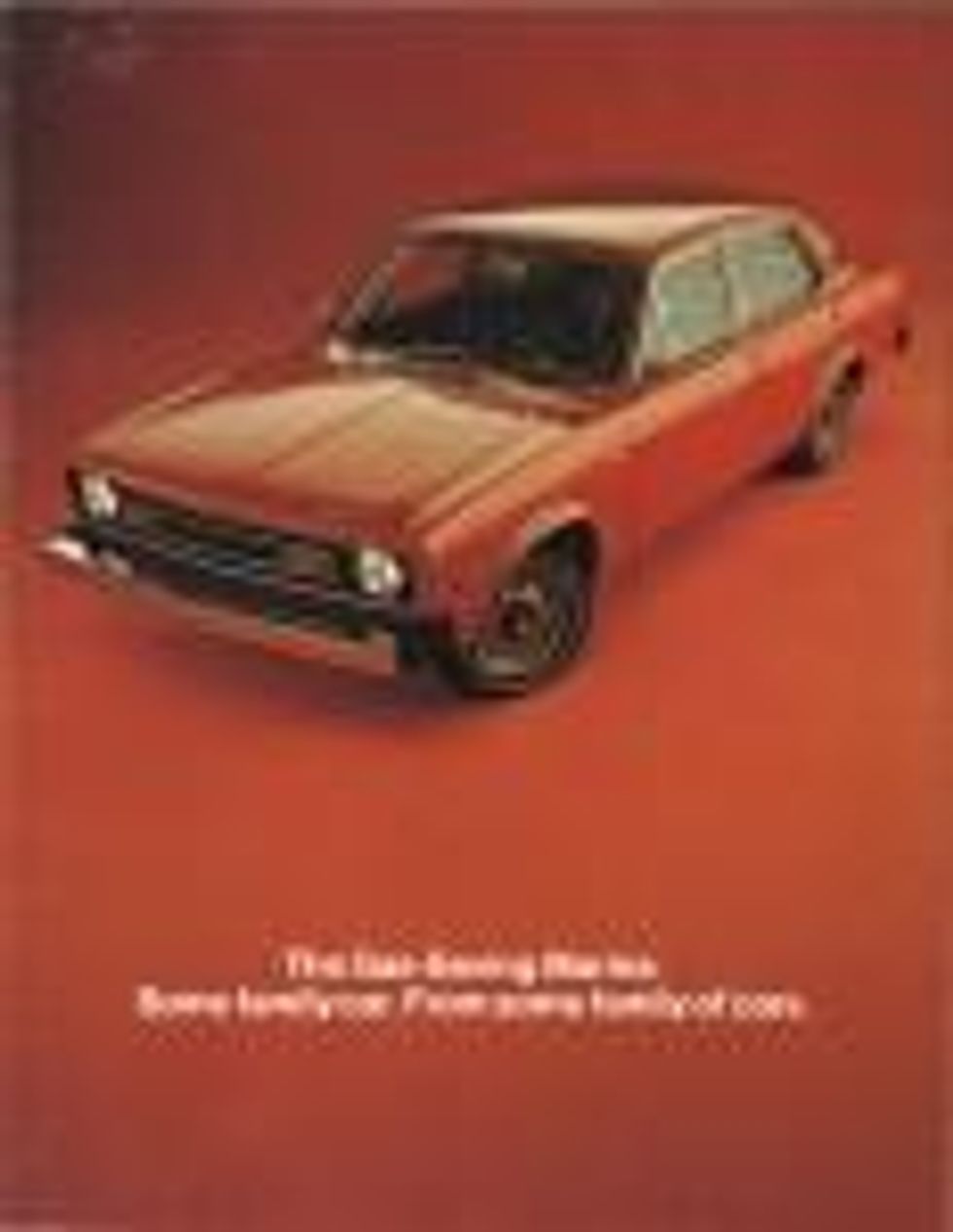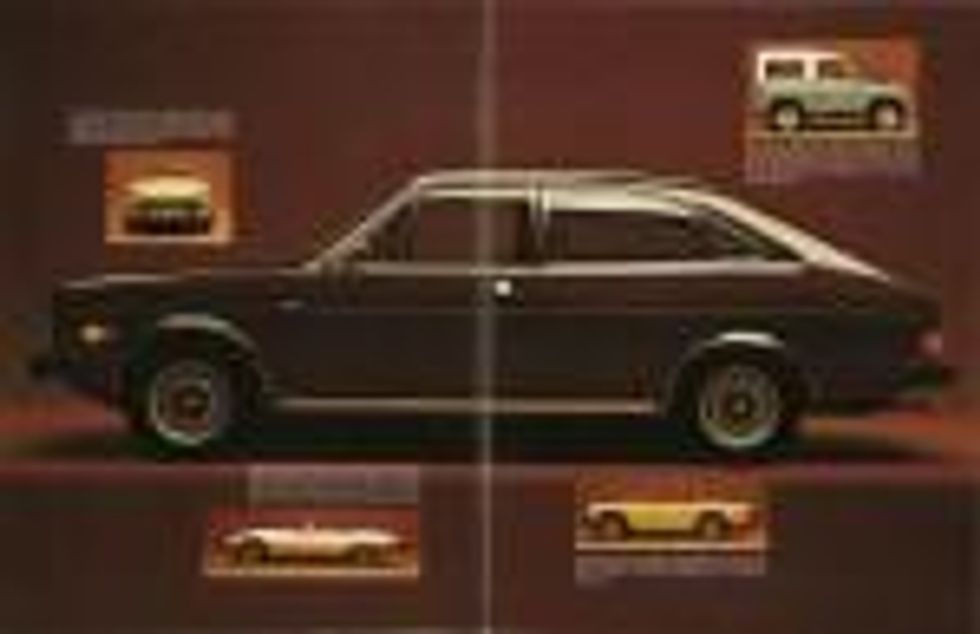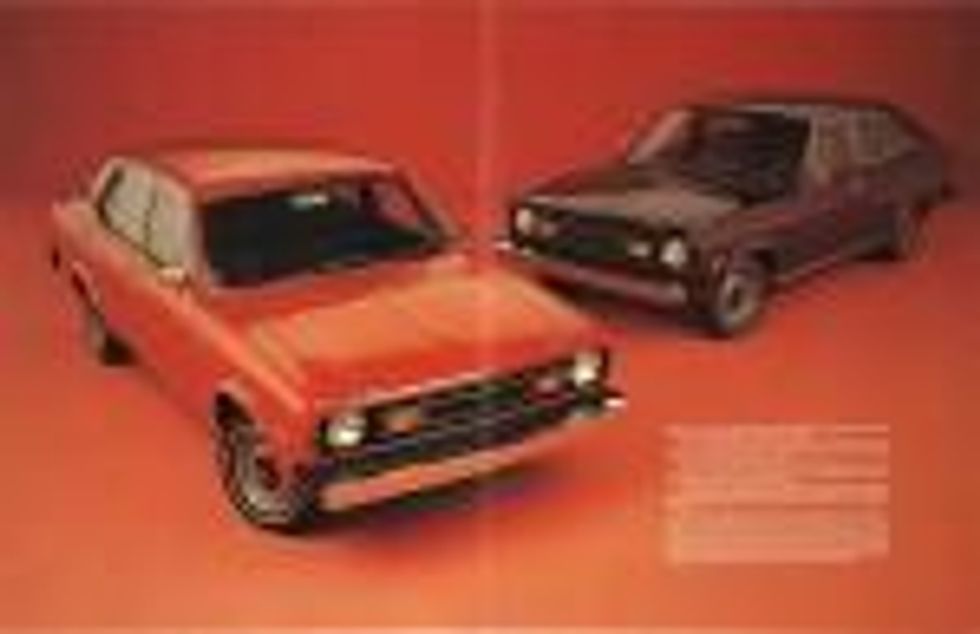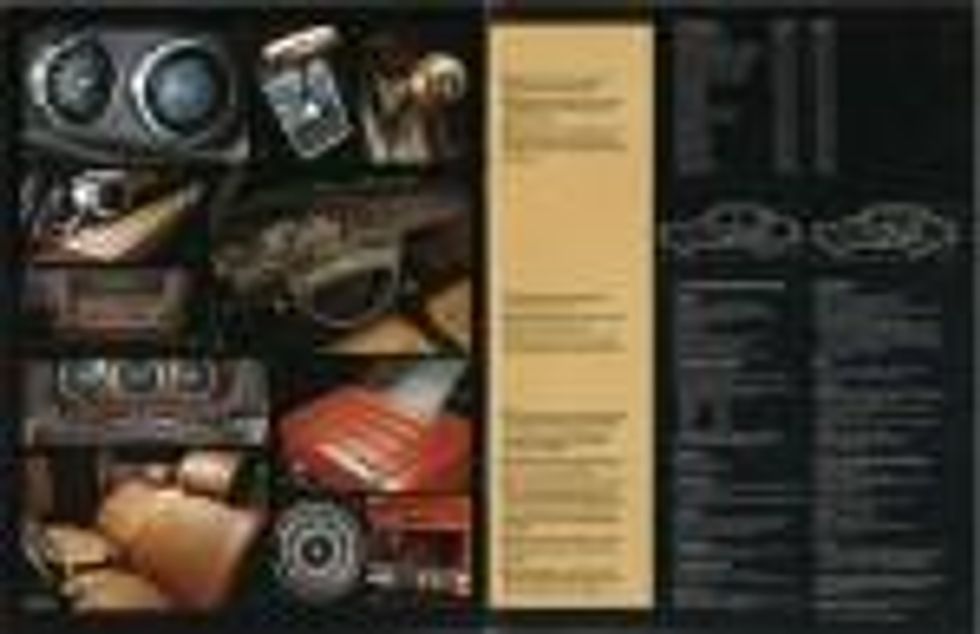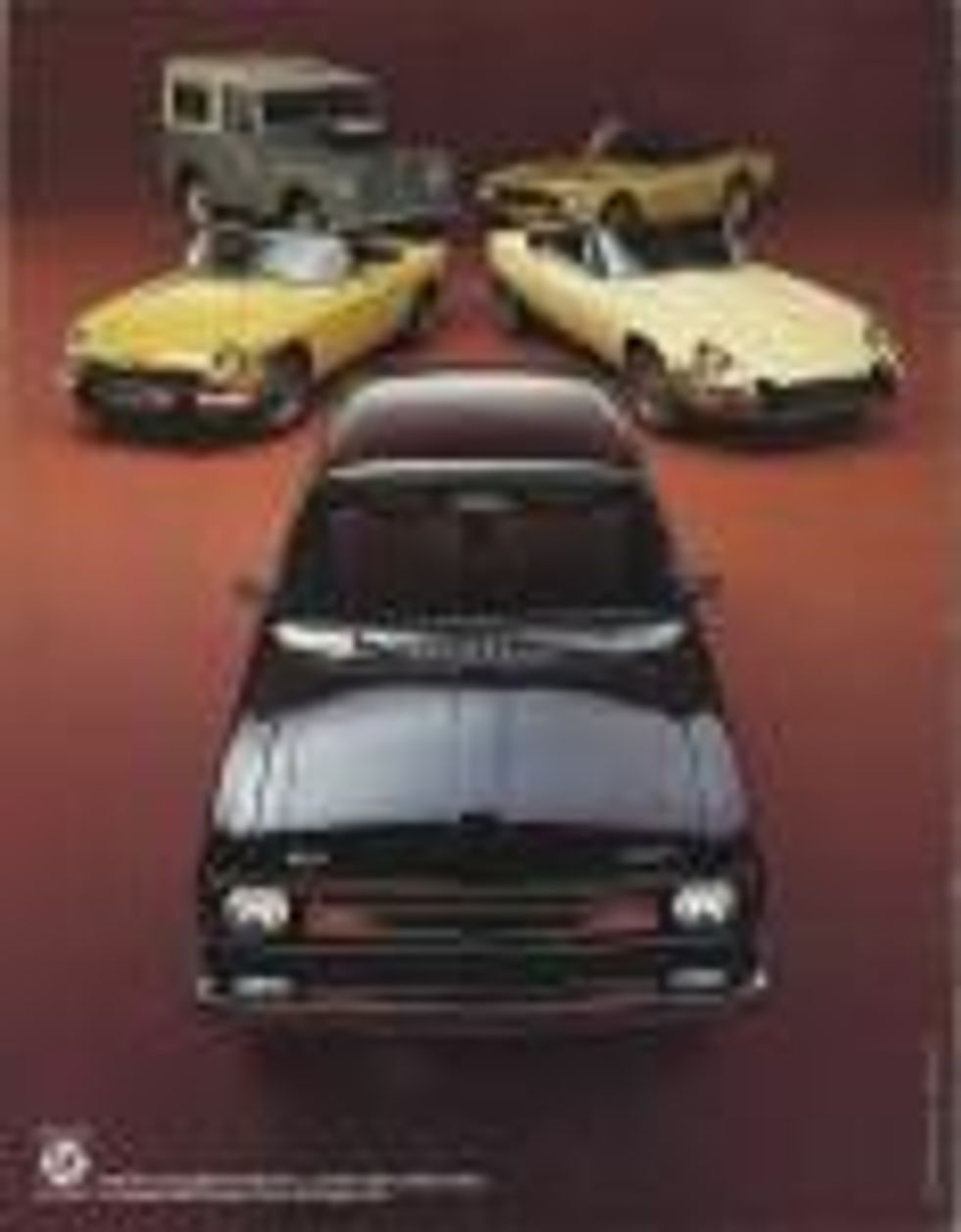
Buy
Resources
Entertainment
Magazine
Community
In This Article
Category:
Automobilia
Images from the brochure collection of Hemmings Motor News
When was the last time you saw a Marina? We can't really remember, either, and maybe that's because, out of the three model years it was sold here (1973-1975), roughly 23,000 were purchased, and an estimated 24 remain. Our U.K. friends can chime in, as surely more examples have survived in the car's home market, where the Marina was sold as a Morris (and was a running punchline for the former hosts of Top Gear).
Austin parent company British Leyland took advantage of the much-loved models in its well-known stable of brands to help sell the newcomer, trotting out the 1974 MG MGB, Triumph TR6, Jaguar E-type Series 3 OTS and Land Rover Series III to prove its points. The MGB's 1,798-cc four-cylinder—in single-carburetor form—powered the Marina, as called out in the "1-8" badging on the sedan's hood and front fenders. The MGB even shared its color chart with these Austins, including the distinctive "Aconite" purple, "Blaze" orange, "Bracken" orange, "Damask Red" maroon, "Harvest Gold," "Mirage" grey and "Tundra" olive.
The four-seat fastback Marina GT may have been largely style-free, but it made for a surprisingly sporty and fun drive.
So, do you have any Marina stories? Chime in with comments, and click on the brochure images below to enlarge.
Recent
Photo: Provided By Author
I turned 18 in late 1977. Ordinarily it would have been just another birthday, especially considering I had my driver’s license less than a year, but it was significant in that I was hired as a valet parking attendant at The Manor, a well-known fine dining restaurant and caterer - that doubled as a very popular wedding venue - located in West Orange, New Jersey. It also meant I could leave behind yard work, dog care, and the sporadic odd jobs of scooping ice cream and delivering newspapers.
The Manor sat on an extensive mountainside property adjacent to a wooded reservation and a golf course, so it was a great place to work outside in the fresh air. Visitors entered the property through tall gates and navigated a tree-lined driveway that led to the grand entrance of the pillared Georgian mansion. Valet parking was free and not required. If visitors opted for valet service, vehicles were driven from the main entrance to either an upper or lower lot. The farthest parking spaces were more than a quarter mile away from The Manor’s front door.
I had been into cars since childhood, so this was a magical job. I was part of a crew of six or seven that worked for tips, and we wore orange coverall uniforms so that we were easily seen at night. We routinely parked and returned more than 400 cars on a busy Saturday, with parties in the afternoon and then again at night, together with public dining.
Jockeying cars for position in shrinking lanes during return rush times made me a better and more precise driver. Another benefit was that I developed a higher appreciation for well-designed dashboards, budding smart controls, and quality upholstery. I preferred gauges to warning lamps, and I intensely disliked the flashing green and yellow dashboard fuel economy indicators that seemed unwelcome in luxury cars. The only way to make the annoying indicator stay green was to coast.
As a crew, we elbowed each other to park the hot imports, such as BMW’s 2002, Datsun’s Z variants, the first Honda Accords, Toyota Celicas, and less frequently, Volkswagen Sciroccos. These were all well-equipped, light, quick, and easy to park. It was also possible to shift them into higher gears for test drives by taking the long way around to the lower back lot. As far as I knew, none of us ever got a Porsche 911 out of second. Our boss knew the joyride risk, so we had to keep numbered dashboard tickets in sequence for assigned spaces that discouraged long drives around the property.

I have many fond memories of the job. To start, the things people left in their vehicles were nothing short of amazing. There were open bills with private information in plain view, and mail of every other conceivable variety, as well as checkbooks, laundry, arts, and crafts in all stages of non-completion, sticky food wrappers, and other trash. I also quickly learned that a tip amount didn’t always correspond to the expense or condition of the car after one guest left a caged guinea pig in his 1967 Pontiac Le Mans when he arrived late for a wedding reception. Aside from needing to be washed and vacuumed, that car was quite fragrant. It was a dry day, so I lowered the side windows, and we took turns checking the pet as we ran to and from other vehicles. Later, the guest told me he was glad the party was over and was eager to reunite the guinea pig with his young daughter. Having noticed us checking on the pet, the car owner gave me the biggest tip I ever got to fetch a car.
Another unusual thing happened while parking a 1975 Buick LeSabre sedan. Two people got out and went inside for dinner and as I got in immediately noticed the aroma of freshly baked bagels emanating from two gigantic bags that took most of the rear seat, nearly reaching the headliner. After parking the car, I was spooked by a low voice from the far-right of the back seat that asked, “Howee doin’?” I had not seen the slight fellow partially hidden by one of the tall bags, and all I could ask was if he intended to go inside. He said he didn’t want a fancy dinner, just a nap. He offered bagels to the entire crew, which were delicious, and stayed in the car and slept for two hours.
Rare cars would roll up on occasion, including one almost everyone guessed was a Maserati, though I recognized it as a Facel Vega. The exhaust growl of the Chrysler Hemi V-8 was positively rhapsodic, and the grand tourer had polished wood throughout its interior. We parked it in a special spot on an outer aisle near the front door and overheard customers speculate what it was while waiting for their own cars. When the tweedy owner eventually came out, my boss, Ray, was determined to sound smart and amuse himself. He conspicuously and formally signaled, “Christopher, the Facel Vega, please.” Seeing where we placed his pride and joy, the owner gleamed. He may have enjoyed that moment more than his dinner.
Another story involved a regular customer’s Cadillac Seville during lunch hour, when Ray often let me work alone so he could get a break. Two County Sheriff’s detectives stopped to tell me they were looking for two inmates who had escaped from the local penitentiary wearing–what else–orange coveralls. They were last seen running on the neighboring golf course. Of course, we always left keys in the ignition of parked cars. The detectives asked how many cars remained from lunch, and whether I could account for each. To my dismay, the Cadillac (one of only three cars left in my charge) was gone! The owner was very classy when the detectives needed his license plate number and unselfishly said he was glad I had not run into the thieves. Luckily for me, the car was recovered unscratched at a nearby shopping center, but we never heard if the thieves were caught.
I rarely drove a car onto the open road, but one exception was a permanent resident’s 1976 Rolls Royce Silver Shadow. The luminous dark red sedan was overdue for its annual state inspection and the owner’s wife “volunteered” me to drive it to the inspection station in the next town. The engine was so quiet and vibration-free that I had to concentrate to hear it. The interior was beautifully appointed with the finest leather I had ever seen or touched. Intuitive controls were set in burled walnut. In my opinion the steering wheel was somewhat primitive and too hard for an ultra-luxury auto, but it was a minor nitpick since the car was a magic carpet. It literally floated when put in drive. As expected, there were no buzzes, squeaks, or rattles. It handled well and predictably with adequate road feel, despite its considerable weight. Power came immediately at the slightest touch, suggesting ample reserve, and the Rolls-Royce stopped on a dime.

Admittedly, I was very nervous driving it, even when it seemed other drivers stayed out of the way once I reached a multi-lane avenue. The inspection station was in a not-so-nice area on a narrow, bumpy street, and being near closing time the station was busy. I had to get in a line that snaked around the block and all I could do was hope nobody hit the darn thing.
As I crawled to the entrance, the inspection staff was laughing and pointing at me, still wearing my orange coveralls: “Hey kid, how did you get out of jail and where did you get that car?” Fortunately, my uniform sported a company crest. Seeking mercy, I said it was the boss’ car. Then the Rolls failed its emissions test. Adding to the insult, the dented, oxidized Volkswagen Beetle behind me passed with flying colors. In those days, a sticker with a big red circle signifying failure was affixed to the windshield’s lower left corner. You couldn’t miss it.
I finally relaxed when I pulled the Silver Shadow into the familiar driveway without incident. To my surprise, the owner’s wife was happy to see that the car failed, because now she could get it tuned up without further debate. Apparently, her husband was always working and neglected his cars. We were reminded of that later when we had to jump the battery in his seldom-driven Jaguar XJ12. The next time I saw the Rolls it had a proper inspection sticker.
After parking cars for eighteen months, I transferred inside to become a bartender as my college days progressed. I missed handling the cars, but not enduring cold winter nights or donning those orange coveralls. Over the years I have almost always insisted on parking my own car, but when valet parking is unavoidable, particularly in a city, I tip in advance. It’s remarkable how a few dollars will often gain a spot close to the attendant’s booth, sometimes with a safety cone next to our car.
Keep reading...Show Less
Photo by Matthew Litwin
Americans rediscovered factory performance thanks, in part, to NASCAR’s first official Strictly Stock (quickly renamed Grand National) race, held on June 19, 1949, on Charlotte Speedway’s ¾-mile dirt oval. What made the 200-lap contest compelling to the 13,000 attendees was a relatable starting field of 33 factory-stock cars (with minor provisions allowed for safety). Of the nine makes that took the green flag (Buick, Cadillac, Chrysler, Ford, Hudson, Kaiser, Lincoln, Mercury, and Oldsmobile), Jim Roper and his 1949 Lincoln were declared victors following the disqualification of Glenn Dunnaway and his 1947 Ford, the latter’s rear spring having been modified for its day-to-day life as a moonshine hauler.
By the end of the 1955 season, Buick, Chevrolet, Oldsmobile, Chrysler, Dodge, Plymouth, Ford, Mercury, Hudson, Nash, Studebaker, and even Jaguar, had been added to the list of race-winning manufactures. Absent was Pontiac, though not for a lack of effort. Thirteen drivers had entered Pontiacs, a combined total of just 25 races. Freddie Lee provided the best result, a fourth, at Carrell Speedway in Gardena, California, on June 30, 1951.
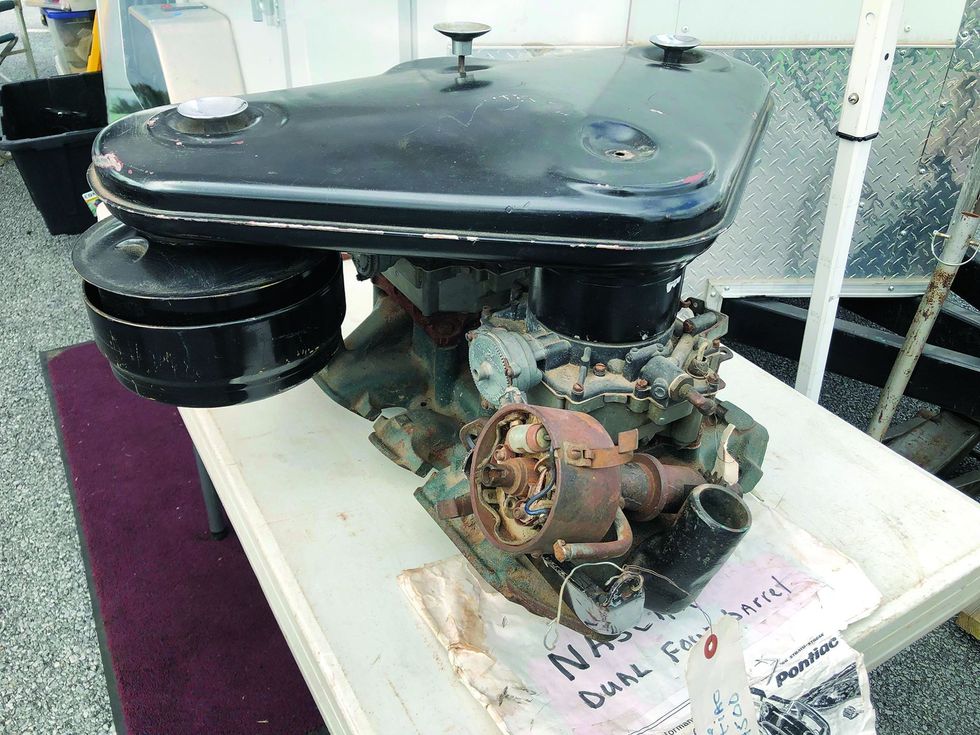
Photo by Matthew Litwin
Race wins touted in national headlineswere not lost on manufacturers, so by the start of the 1956 season nearly every major domestic brandhad invested performance resources into NASCAR. Pontiac initially supported two teams: Jim Stephens (Stephens Pontiac), and A.L. Bumgarner (Brushy Mountain Motors). Each were armed with a new-for-1956 engine designed for racing: a 316.6-cu.in. V-8 fitted with dual Rochester four-barrel carburetors that, along with a high-performance camshaft, dual-point distributor, specialized valley cover, and 10:1 compression cylinder heads, conspired to produce 285 horsepower (in street trim, mind. It’s well-known that racers knew how to make more horsepower).
A Pontiac win looked favorable, beginning with the sixth race of the season at the Daytona Beach/Road race, where Stephens’ two-car effort - with Ed Kretz and Cotton Owens - qualified 3rd and 4th, while Junior Johnson, in Bumgarner’s Pontiac, qualified 26th in the 76-car field. None saw the checkered flag. Johnson crashed, and the Stephens effort was met with mechanical woes. It was a sign of things to come. Strong as Pontiac was, bad fortune and mechanical reliability were its Achilles’ heel. Pontiac attained just 17 top 10 finishes with a best of 3rd recorded by Pat Kirkwood in a Stephens’ Pontiac.
Going winless, coupled with poor street ability of the dual-quad 316.6 V-8, spurred Pontiac to develop Tri-Power and fuel-injected 347-cu.in. engines for 1957. They became instant hits on the track - the brand notched two wins prior to a June rule change that mandated a single four-barrel induction system - and on the street, leaving the dual-quad 316.6 a nearly forgotten footnote of Fifties factory performance.
Rare reminders, however, still exist, such as this bred-for-NASCAR 1956 Pontiac twin Rochester carburetor and intake manifold assembly spotted for sale at the 2023 AACA Eastern Fall Meet in Hershey, Pennsylvania. Also included as part of the $4,500 package price was the system’s specific air cleaner assembly, which looked similar that of Cadillac’s (the two reportedly would not interchange without modifications). Save for rebuilding the carburetors, it looked ready to install on a specific “HY” stamped block.
1956 Pontiac Dual four-barrel induction setup
ASKING PRICE:$4,500
FOUND AT: 2023 AACA EASTERN FALL MEET (HERSHEY, PENNSYLVANIA)
Keep reading...Show Less

